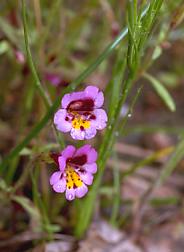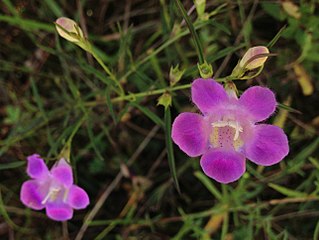
Orobanchaceae, the broomrapes, is a family of mostly parasitic plants of the order Lamiales, with about 90 genera and more than 2000 species. Many of these genera were formerly included in the family Scrophulariaceae sensu lato. With its new circumscription, Orobanchaceae forms a distinct, monophyletic family. From a phylogenetic perspective, it is defined as the largest crown clade containing Orobanche major and relatives, but neither Paulownia tomentosa nor Phryma leptostachya nor Mazus japonicus.

Phrymaceae, also known as the lopseed family, is a small family of flowering plants in the order Lamiales. It has a nearly cosmopolitan distribution, but is concentrated in two centers of diversity, one in Australia, the other in western North America. Members of this family occur in diverse habitats, including deserts, river banks and mountains.

Agalinis is a genus of about 70 species in North, Central, and South America that until recently was aligned with members of the family Scrophulariaceae. As a result of numerous molecular phylogenetic studies based on various chloroplast DNA (cpDNA) loci, it was shown to be more closely related to members of the Orobanchaceae. Agalinis species are hemiparasitic, which is a character that in part describes the Orobanchaceae.

Chloropyron palmatum is an endangered species of salt-tolerant, flowering plant in the family Orobanchaceae. It is a low, highly branched herbaceous annual with each flower enclosed by a single, characteristically palmate bract. It is known by the common names of palmate salty bird's-beak and palmate-bract bird's-beak.
Diplacus clevelandii is an uncommon species of monkeyflower known by the common name Cleveland's bush monkeyflower. It was formerly known as Mimulus clevelandii.

Erythranthe filicaulis, known by the common name slender-stemmed monkeyflower, is a species of monkeyflower. It was formerly known as Mimulus filicaulis.
Erythranthe inflatula, synonyms Mimulus inflatulus and Mimulus evanescens, is a rare species of monkeyflower known by the common name disappearing monkeyflower. It is native to the western United States, where it is known from about ten locations in and around the Great Basin within the states of Idaho, Oregon, and California; it is also found in Nevada. Specimens of the plant had been catalogued as Mimulus breviflorus, but on further examination it was evident that they were a separate, unclassified species; this was described to science in 1995. It is thought that the plant may have evolved via hybridization between Erythranthe breviflora and Erythranthe latidens, or that it evolved from E. latidens and then into E. breviflora.

Diplacus pictus is a species of monkeyflower known by the common name calico monkeyflower.

Diplacus tricolor is a species of monkeyflower known by the common name tricolor monkeyflower. It is native to Oregon and California. It grows in seasonally wet habitats such as meadows and vernal pools, including those in the San Joaquin Valley and near north coast oak woodlands. It was formerly known as Mimulus tricolor.

Pedicularis contorta is a species of flowering plant in the family Orobanchaceae known by the common names coiled lousewort and curved-beak lousewort. It is native to western North America, including southwestern Canada and the northwestern United States, where it grows in moist mountainous habitat, such as bogs, shady forests, and meadows. It is a perennial herb producing one or more stems up to 40 centimetres (16 in) tall from a caudex. The leaves are up to 18 centimetres (7.1 in) long, lance-shaped to oblong, and divided into many linear lobes which may be toothed or smooth-edged. The inflorescence is a raceme of flowers occupying the top of the stem. Each flower is a centimeter long or slightly longer, white to yellowish in color, and divided into a coiled or curved beak-like upper lip and a flat, three-lobed lower lip. The fruit is a capsule up to a centimeter long containing seeds with netted surfaces.

Agalinis aspera, the rough agalinis, rough false foxglove, or tall false foxglove, is a non-poisonous plant of the genus Agalinis, habitating in the dry prairies. It can grow to be about eight to twenty-four inches tall. When the flowers bloom, the colors vary between purple and pink.

Erythranthe michiganensis is a rare species of flowering plant in the lopseed family, known by the common name Michigan monkeyflower. This species occurs only in the Grand Traverse and Mackinac Straits areas within the American state of Michigan. It is one of only three plant species that are endemic to Michigan, with the other two being Voss's Goldenrod and Packera insulae-regalis.

Erythranthe gemmipara is a rare species of flowering plant in the family Phrymaceae, known by the common name Rocky Mountain monkeyflower. It is endemic to Colorado in the United States, where there are eight known occurrences. It was formerly known as Mimulus gemmiparus.

Agalinis auriculata is a species of flowering plant in the family Orobanchaceae known as earleaf false foxglove, auriculate false foxglove, and earleaf gerardia. It is endemic to the United States, where it occurs from New Jersey west to Minnesota and throughout most southern states.

Agalinis skinneriana is a species of flowering plant in the family Orobanchaceae known by the common names Skinner's gerardia, Skinner's false foxglove and pale false foxglove. It is native to North America, where it occurs in Ontario south to Missouri and Louisiana.

Agalinis paupercula, commonly known as the smallflower false foxglove, is a hemiparasitic annual plant native to the eastern parts of the United States and Canada. Found in open, moist areas, its purple flowers are borne on a 30-to-70-centimeter stem, and bloom in August and September. The species has often been treated as a variety of Agalinis purpurea, the purple false foxglove, and preliminary genetic evidence suggests that the two are, in fact, a single species.

Aureolaria virginica, the downy yellow false foxglove or downy oak leach, is a perennial forb native to the eastern United States and Canada, which produces yellow flowers in summer.

Agalinis purpurea is an annual forb native to the eastern United States and Canada, which produces purple flowers in late summer or early fall.

Agalinis tenuifolia, known by the common names common gerardia, slender false foxglove or common false foxglove, is an annual forb native to the eastern and southwestern United States, and Canada, which produces purple flowers in late summer or early fall.

Agalinis gattingeri, the roundstem false foxglove, is an annual hemiparasitic forb measuring between 10.5 and 60.5 cm in height.


















